What happened at sea
Families of Israelis held in Gaza left Ashkelon on small boats on August 7, 2025, in a loud protest to press leaders for action to free their loved ones, and the voyage lasted about two hours as the group stayed a safe distance from Gaza coast because of military limits and risk, and members threw fifty yellow life jackets into the water, one for each hostage they say remains captive, while calling for help and shouting messages into megaphones.
A nation split over a big plan

At the same time, Israel’s security cabinet met to debate a plan that Prime Minister Benjamin Netanyahu said aims to take control of Gaza City as part of a broader push to remove Hamas and then transfer rule to friendly Arab forces, but top military leaders warned the move could trap Israel in a long fight and raise real danger to the hostages and to soldiers, and the meeting exposed sharp splits among ministers over the scope and timing of any new ground action.
What families say and the numbers they fear
Relatives told reporters that a bigger military push would be like a death sentence for captives, and some former hostages argued that deals and talks have brought people home in the past and that a deal must be the main route now, while officials put the count of people taken on October 7, 2023, at about 251 and say around fifty are still in Gaza with some of those believed to have died, and these mixed figures add to family fear and public tension.
What this means on the ground
A full push into the densely built center of Gaza would likely displace large numbers of civilians and add to a dire aid crisis, and that is one reason many outside governments and aid groups warn against sweeping operations that move fast and wide, and inside Israel many worry the military may not be ready for a long occupation that would cost lives and money and could inflame the region.
My analysis
The families acted to shift the story from maps and plans to faces and loss, and their flotilla forced a human moment into a debate that has mostly lived in closed rooms and strategy briefs, and that matters because leaders now make choices under public pressure. A step to control Gaza might bring short term gains against armed groups, but it will raise the cost in lives and resources, and it will narrow the chance for a deal that could bring more captives home.
If leaders put rescue and release first, they may need new channels and pressure from other countries to push a swap or release. If leaders go straight to a wide ground move, they may risk the hostages more and harden public anger abroad and at home. In short, the choice now is not only military; it is also political and moral, and each option carries hard trade offs that will show quickly in people’s lives.
Sources: timesofisrael.com


